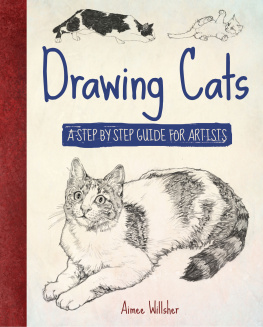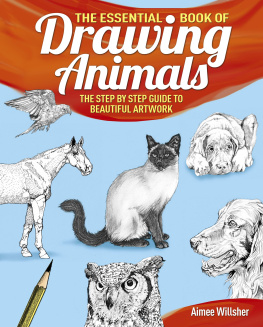Table of Contents
Landmarks
Drawing Cats
A STEP-BY-STEP GUIDE FOR ARTISTS
Aimee Willsher
CONTENTS
Introduction
Cats are among the worlds most popular pets, as they are easy-going, independent creatures; they love to be out and about but always return for some love and attention from their owner. No two cats are the same and no one cat will be the same from one day to the next! Even if you dont have a cat of your own, just take a walk down any residential street and you are bound to encounter one sooner or later; some of your friends probably have cats, too. This easy availability makes cats excellent subject matter for any budding artist who wants to develop their drawing skills.

There are many breeds of cat, offering a diversity of physical characteristics with which to experiment and develop your style and technique.
We shall start by looking at some basic anatomy and how the form of the cat can be broken down into the simple shapes that everyone will be familiar with. We shall then look at how to combine these shapes to create the more complex outline of the cat and finally learn visual tricks to add flesh and texture to the outline and capture the illusion of a three-dimensional form upon the flat piece of paper.
After the basics have been covered you will be guided through drawing projects, from easy to more challenging, using step-by-step examples which demonstrate how to build up a simple outline into a beautifully detailed composition. By following this method, at the end of your journey through this book you will be able to immortalize cats in beautiful works of art that can be treasured forever.
GETTING STARTED
You dont need to splash out on a lot of expensive materials before you start your artistic adventures; a pencil and a few blank sheets of paper are all you need to begin. Making a first mark on pristine paper can be daunting, but dont let the possibility of making a mistake unsettle you. Learning to draw is just like attempting to acquire any new skill; your first attempts may not be perfect but with a little practice and determination you will soon see how your techniques become increasingly sophisticated.
The first exercises in the book may seem a little mundane, but by getting these simple techniques under your belt at an early stage you will be able to tackle more complex images very quickly and with relative ease. You will soon be making beautiful drawings that any artist would be proud of!

Basic materials and accessories
The enormous variety of materials and brands to be found in art supplies stores on the street and online can be daunting, but as you have already learnt, all you need is a few basics to begin with. As you continue your exploration of drawing techniques you will be able to decide for yourself the types and brands of materials that work best for you. Most essential materials for drawing are relatively inexpensive, so there is plenty of room for experimentation.
PAPER
To start with, all youll need is a standard sketch pad from your local stationery shop. As you move on to experimenting with different materials, though, its a good idea to use a specialized paper which will provide a surface designed to get the best out of a particular medium. Paper is graded according to its weight, and this is usually displayed on the front of a sketch pad the higher the number, the thicker the paper. Paper graded as 120 gsm (75 lb) is quite thin, fairly cheap and great for making quick practice sketches. As the weight of the paper increases, so does the price; a thick 300 gsm (140 lb) paper is perfect for working on more developed, detailed drawings. Its thickness means it can withstand blending, watercolour washes and heavy shading without tearing or curling.
Another factor to consider is the surface. Paper with a texture or grain is great when you start experimenting with charcoal and pastel since the nature of the surface gives the medium something to engage with.
PENCILS
The trusty pencil is a tool that everyone will have used since early childhood. Pencils are a perfect medium with which to start, as they are hugely versatile great for making quick sketches as well as more detailed, ambitious drawings.
Pencils are graded according to the density of their leads, from very soft to very hard. The grade is shown on the side of the pencil by means of a letter (or letter and number). Hard leads are graded as H to 9H, with 9H being the hardest; soft pencils are B to 9B (the softest). The HB pencil with which we are all familiar falls in the middle of this density scale.
Hard pencils are good for making fine, light lines; softer pencils are for creating dark lines. They are easily blended and can be used to build up smooth gradated shading. I tend not to use really hard pencils for drawing, because the lines they produce are too light to be easily visible. Its a good idea to buy a tin of pencils containing a range of leads which will cater for all your needs when you are starting to discover the results you can obtain from different grades of pencil.






